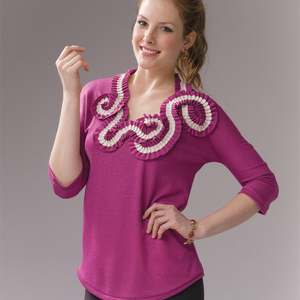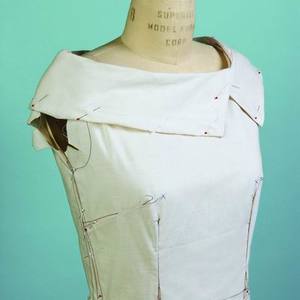How to Use a Sewing Stiletto
The point is to maneuver fabric safely
The sewing stiletto is the modern descendant of the awl tool, used in making the earliest examples of clothing. Its sharp point could create holes for lacing together animal skins, before the invention of the needle. As sewing became more sophisticated and woven fabrics developed, the awl remained useful. Its sharp point was used to part a fabric’s weave so eyelets and buttonholes could be stitched without cutting the fabric, creating a more durable opening. It is still the recommended tool for creating hand-sewn eyelets.
With the advent of the home sewing machine, a new use for the awl developed. Sewers needed an “extra finger” that could safely reach into tight spaces in the stitching area or get close to dangerously hot irons. A new type of tool evolved from the awl, the modern sewing stiletto.
Sewing stilettos come in a variety of shapes, sizes, and materials. Most share the same basic shape: a long, slender tool tipped by a tapered point. The acute point enables the stiletto to hold small areas of fabric with accuracy. Used in a traditional manner, stilettos are invaluable for keeping seam allowances from flipping in the wrong direction while you’re stitching across intersecting seams. Variations on the basic stiletto include the trolley needle, a type of stiletto that is worn like a thimble on the index finger rather than held in the hand. Another stiletto variation with two prongs is especially handy for holding larger sections of fabric in place.
I’ll introduce several types of stilettos, from classic designs to newer multipurpose models. There are a number of styles, including those with ergonomic handles or blunted tips for safety. Try different stilettos to find one that works for you.

Classic versions
The point of a stiletto helps you turn under appliqué edges and poke out stubborn collar points. It can even be used in lieu of a seam ripper to pick stitches from a seam. Stilettos are especially loved by quilters because they work with narrow seam allowances. A stiletto can increase accuracy by providing greater control and can gently ease curved seams. Some metal stilettos have a textured point to grip the fabric and make it easier to maneuver. Dollmakers and crafters also find stilettos handy for pushing stuffing into tight spaces. A molded plastic stiletto’s relatively blunt point reduces the risk of damaging fabric.
Multipurpose options
Many commercially produced stilettos perform several functions. Some feature a wedge-shaped base that can be used to finger-press seams. Others are slender enough to be used as a bodkin and are designed to thread material through a casing. Heat-resistant versions have a silicone tip for gripping or pushing fabric while pressing.

Substitutes
Although specially designed sewing stilettos are useful, some on-hand tools can stand in for a stiletto.
Bamboo skewer
A rudimentary example of a sewing stiletto is a bamboo skewer, such as the type used for grilling kebabs. Although it lacks the sophistication of specially made sewing stilettos, the humble skewer does have its uses. Doing ribbon embroidery by machine is a great time to use a wooden skewer. The work is often done close to the needle, with the presser foot removed. If the needle strikes the relatively soft bamboo skewer, it is less likely to bend or break than if it struck a plastic or metal stiletto.

Porcupine quill
A quill’s fine, barbed tip has a bit of grip, and the needle will not break if it strikes the soft quill. African porcupine quills are often larger and sturdier than other available quills, and may be most suitable for use as a stiletto. Humanely sourced quills can be found online.
Ice pick
An ice pick usually features a strong, sharp point and is good for managing thicker fabrics as they go through the sewing machine. Ice picks often come with a point protector for safe storage. An ice pick’s metal point does not melt if used to assist during pressing, but it does heat up, so be careful. Ice picks usually have a large, comfortable handle, which can be good for sewers who need an ergonomic grip.

Katrina Walker teaches online and at shows and guilds nationwide. KatrinaWalker.com
Photos: Mike Yamin
Sources:
- Fons & Porter Machine Quilter’s Friend, SewingPartsOnline.com
- Clover Hold It Precision Stiletto, Clover-USA.com
- ByAnnie’s Stiletto & Pressing Tool, ByAnnie.com
- That Purple Thang, FatQuarterShop.com
- Ice pick, Amazon.com



































Great article! I wanted to mention one more substitute; a manicure or "orange" stick. It's wooden, sturdier and smoother than a bamboo skewer, 6-8" long, and has a point on one end and a very handy chiseled end on the other for holding things in place while sewing or ironing. I keep a couple handy always while sewing!
If there are any other musicians out there: I've found that a flute cleaning rod is great to use as a bodkin for turning fabric tubes rightside out! For smaller tubes, a piccolo cleaning rod is perfect.
The link to Clover stilletto doesn't work and when you search their website, they can't find one!
Thanks for letting us know. The link to the Clover stiletto has been updated.
Carol Fresia, Threads Senior Technical Editors
Thanks for the great article! I have both the stilettos from ByAnnie.com and That Purple Thang, but have also used a bamboo skewer previous to these. Such useful tools. I'm sure Annie Unrein didn't envision her stiletto used in gourd crafts, but I use mine to nudge leather lacing along the edge of a gourd when I'm creating a braided trim. Works better than using fingernails!